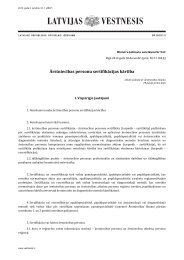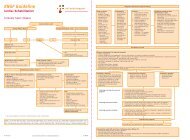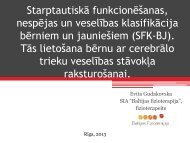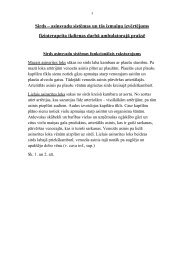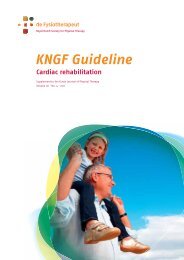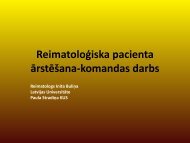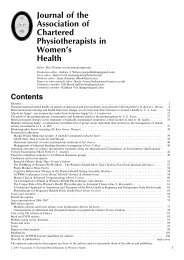You also want an ePaper? Increase the reach of your titles
YUMPU automatically turns print PDFs into web optimized ePapers that Google loves.
<strong>Low</strong> <strong>Back</strong> <strong>Pain</strong>: Clinical Practice Guidelines<br />
patients who received interventions that were not matched<br />
with their examination findings.<br />
The classification system described in these practice guidelines,<br />
linked to the ICF, parallels the treatment-based classification<br />
system 107 with 3 noteworthy differences. The first<br />
difference is that the categories in these clinical practice<br />
guidelines incorporate the following ICF impairments of<br />
body functions terminology: low back pain with mobility<br />
deficits, low back pain with movement coordination impairments,<br />
low back pain with related lower extremity pain, low<br />
back pain with radiating pain, and low back pain with related<br />
generalized pain. The second difference is the addition of the<br />
low back pain with “related cognitive or affective tendencies”<br />
and “generalized pain” categories to provide a classification<br />
for patients with pain who, in addition to movement-related<br />
impairments of body function, have impairments of mental<br />
functioning (appropriateness of emotion, content of thought)<br />
and impairments of sensory function (generalized pain). The<br />
third difference is the addition of the patient’s level of acuity<br />
to this ICF-based classification system, with the level of acuity<br />
defined in terms of (1) time since onset of symptoms and<br />
(2) movement/pain relations.<br />
These ICF-based clinical practice guidelines will<br />
expand on the work of others260,283 V<br />
and incorporate<br />
the ICF model into low back pain management.<br />
Specifically, these clinical guidelines will describe the<br />
diagnostic classification categories using ICF impairment of<br />
body functions terminology and link those categories to the<br />
associated ICD condition. These clinical guidelines will also<br />
incorporate the patient’s level of acuity in the description of<br />
the impairment of body functions category, describing the<br />
impairment category/pattern as acute, subacute, or chronic.<br />
In addition to the temporal definitions typically associated<br />
with the acute, subacute, and chronic phases of a patient’s<br />
low back pain episodes, the level of acuity in these clinical<br />
guidelines will also incorporate the relation of the patient’s<br />
reported pain to active movements that the patient performs,<br />
such as bending, or to passive movements that the clinician<br />
utilizes during the physical examination of the patient, such<br />
as segmental motion testing or straight leg raising. The authors<br />
of these guidelines propose that the recurring nature<br />
of low back pain requires clinicians to expand beyond the<br />
time frames traditionally used for acute (less than 1 month),<br />
subacute (between 2 and 3 months), and chronic (greater<br />
than 3 months) low back pain categorization. For example,<br />
clinicians frequently are required to assist patients with<br />
managing acute exacerbations of “chronic” low back pain<br />
conditions. For patients who have had low back pain for<br />
more than 3 months and/or for patients who have recurring<br />
low back pain, these clinical guidelines promote categorizing<br />
acute, subacute, and chronic low back pain based<br />
a14 | april 2012 | volume 42 | number 4 | journal of orthopaedic & sports physical therapy<br />
on movement/pain relations rather than solely using time<br />
since the patient’s initial onset of low back pain. Movement/<br />
pain relations are commonly used in physical therapy for<br />
classifying patients into treatment categories that respond<br />
best to matched intervention strategies, 35,89,103,105,107,108 as well<br />
as to guide dosing of manual therapy, therapeutic exercise,<br />
and patient education interventions. 176 The dosing of interventions<br />
based upon movement/pain relations is consistent<br />
with the concept of tissue irritability and is important for<br />
guiding clinical decisions regarding treatment frequency,<br />
intensity, duration, and type with the goal of matching the<br />
optimal dosage of treatment to the status of the tissue being<br />
treated. Irritability is a term used by rehabilitation practitioners<br />
to reflect the tissue’s ability to handle physical stress 222<br />
and is presumably related to its physical status and the extent<br />
of inflammatory activity present, which is relevant for<br />
the mobility deficit, movement coordination impairments,<br />
and radiating pain diagnostic classifications used in these<br />
clinical guidelines.<br />
ICF Impairment of Body Functions Terminology<br />
and Characteristics<br />
For acute low back pain with mobility deficits, the distinguishing<br />
movement/pain characteristic is that the patient<br />
demonstrates restricted spinal range of motion and<br />
segmental mobility, and that the patient’s low back and low<br />
back–related lower extremity symptoms are reproduced with<br />
provocation of the involved segments, with intervention<br />
strategies focused on reducing pain and improving mobility<br />
of the involved spinal segments.<br />
For acute low back pain with movement coordination impairments<br />
and acute low back pain with radiating pain,<br />
the distinguishing movement/pain characteristic is pain that<br />
occurs with initial to mid-ranges of active or passive motions,<br />
with intervention strategies focused on movements that limit<br />
pain or increase the pain-free movement in the mid-ranges.<br />
For subacute low back pain with mobility deficits, subacute<br />
low back pain with movement coordination impairments,<br />
and subacute low back pain with radiating pain,<br />
the distinguishing movement/pain characteristic is pain that<br />
occurs with mid- to end-ranges of active or passive motions,<br />
with intervention strategies focused on movements that increase<br />
movement tolerances in the mid- to end-ranges of<br />
motions.<br />
For chronic low back pain with movement coordination<br />
impairments and chronic low back pain with radiating<br />
pain, the distinguishing movement/pain characteristic is<br />
pain that occurs with sustained end-range movements or<br />
positions, with intervention strategies focused on move-



